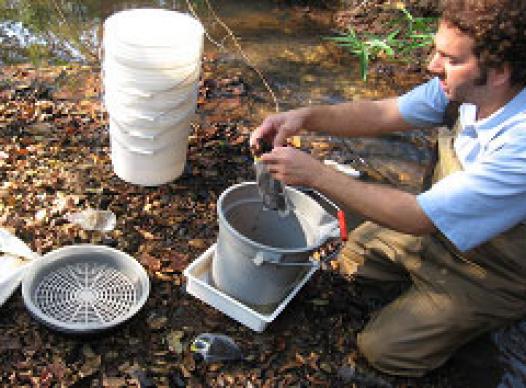Macroinvertebrate Data
Macroinvertebrates are collected according to state protocols during the index period of mid-September through February. A 100-meter reach is designated for assessment and the collected sample is returned to the lab for processing. Using a random selection process, macroinvertebrates are sorted and identified until reaching the target sample size of 200 organisms, plus or minus 20 percent. A list of study sites and macroinvertebrates collected is provided below.
Bug Data
| 2020 | 2019 | 2018 |
| 2017 | 2015-2016 | 2014-2015 |
| 2012-2013 | 2011 | |
Macroinvertebrates Monitoring
Macroinvertebrates are collected following state protocols outlined in the document Macroinvertebrate Biological Assessment of Wadeable Streams in Georgia. The primary purpose of this document is to establish and maintain uniform methodology and quality control guidance for biological data collected within the state. Compliance with these procedures is essential to produce reliable biological data.
Macroinvertebrate sampling is conducted mid-September through February, which is called the Index Period. This Index Period is the biologically optimal sampling season, which occurs when the habitat is utilized most heavily by more mature larvae (late instars) and the food resources have stabilized to support a balanced indigenous community (Plafkin et al., 1989).
A stream reach of 100 meters is designated for sampling, which begins downstream and moves upstream so that habitat is not disturbed before sampling. Within the reach, 20 locations bearing productive and stable habitats are sampled by two team members. One individual collects samples by “jabbing” a D-frame net into the habitat, while the other member keeps up with the number of jabs and compiles collected material in a bucket. Six types of habitats are sampled, including (in order of sampling priority) fast and slow riffles, woody debris/snags, undercut banks/rootwads, leaf packs, soft sediment/sandy substrate, and submerged macrophytes (aquatic plants), if present. When habitats are not present, sampling locations will be reallocated using the priority listed above. The sample is composited, preserved, and returned to the laboratory for subsampling, sorting, and macroinvertebrate identification.
In the laboratory, the sample is evenly distributed in a Caton subsampler, which divides the sample into 30 equal portions (squares). Squares are randomly selected and macroinvertebrates are sorted and identified until reaching the target sample size of 200 organisms, plus or minus 20 percent. Individual organisms are preserved and stored with site identification markers, including sampling location, date of collection and date of the subsample.
Data collected is entered into a multi-metric index database for analysis. Individual metrics are combined to determine an index score which is used to help Cobb County evaluate stream health and aid future management decisions.

Macroinvertebrate Taxonomy
Taxonomy is a hierarchical system used to categorize living organisms into groups with similar anatomical characteristics, as follows:
|
|
|
The Cobb County Stream Monitoring Program identifies collected specimens to the genus level and uses the population data in multi-metric calculations (analytical computations used to evaluate components of the macroinvertebrate community). Results are used to interpret the effects of pollution exposure, habitat stability, and food supply.
For the purposes of watershed assessments, we identify aquatic insects belonging to the orders of Coleoptera (beetles), Diptera (true flies), Ephemeroptera (mayflies), Megaloptera (fishflies, alderflies and dobsonflies), Odonata (dragonflies), Plecoptera (stoneflies) and Trichoptera (caddisflies).
The Cobb County Stream Monitoring Program uses the following taxonomic keys when identifying aquatic macroinvertebrates:
- Aquatic Entomology - The Fishermen’s and Ecologists’ Illustrated Guide to Insects and Their Relatives by W. Patrick McCafferty
- An Introduction to the Aquatic Insects of North America edited by R.W. Merritt and K.W. Cummins
- Aquatic Insects and Oligochaetes of North and South Carolina edited by Brigham, Brigham and Gnilka
- The Water Beetles of Florida by J.H. Epler
- Identification Manual for the Caddisfly (Trichoptera) Larvae of Florida by Manuel L. Pescador, Andrew K. Rasmussen, and Steven C. Harris
Macroinvertebrates

Freshwater macroinvertebrates include aquatic insects, worms, and other invertebrates that live on or within the sediment or other substrates in streams, rivers, and lakes. These organisms spend all, or significant portions, of their lives immersed in water, therefore, aquatic insects are particularly susceptible to localized short-term water quality changes.
The population size and population structure of these macroinvertebrates respond to the effects of acute and chronic pollution as well as changes in the physical environment; therefore, macroinvertebrates serve as continual monitors of environmental quality.
Cobb County has established 13 biological monitoring sites covering each major stream watershed within our borders. Each site is sampled for macroinvertebrate assessment twice in a 5-year period. Results are evaluated along with historical biological, chemical, and habitat data from the same location in order to detect long-term changes in stream health.
Cobb County macroinvertebrate sampling began with a qualitative approach in the 1990’s and developed over time into the quantitative analytical program it is today. Adherence to strict protocols allows our local data to be compared with results from across the state of Georgia.
